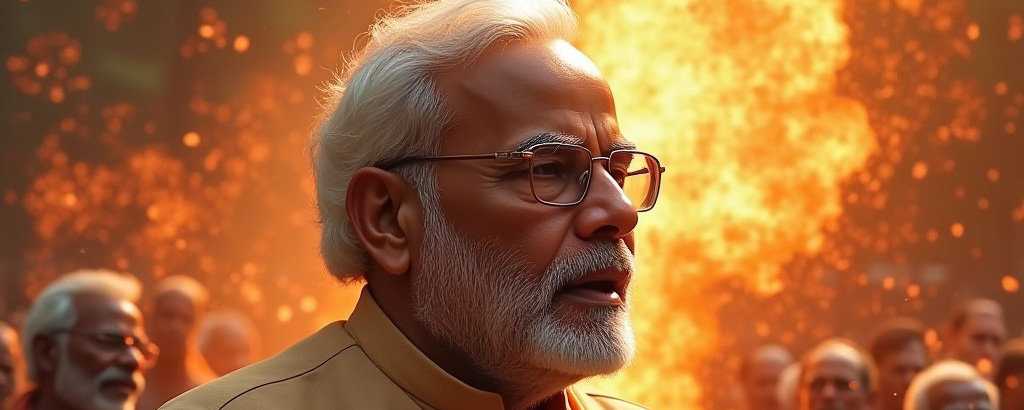Silencing Dissent: The Erosion of Indian Democracy


India’s democracy has always drawn its strength from its diversity, dissent, and vibrant debates. The Constitution upholds freedom of expression as a fundamental right so that every citizen can hold those in power accountable. But over the past decade, a pressing question has begun to echo across the country: Is dissent being suppressed in India? Is the government labelling criticism as anti-national to muzzle the voices of civil society? Today, when we speak of “New India” and dream of becoming a “Vishwaguru” (world leader), it is crucial to examine how much room truly remains for disagreement and critique in this journey of development.
Since the beginning of Prime Minister Modi’s first term, civil society organizations, human rights defenders, journalists, and sections of academia have faced new layers of legal and administrative pressure. One of the biggest tools has been the Foreign Contribution (Regulation) Act or FCRA. Amendments to this law have tightened the noose around foreign funding for NGOs. Iconic organizations like Amnesty International India, which spent decades holding governments accountable for human rights abuses, were forced to shut down operations in India in 2020 after their bank accounts were frozen. Greenpeace, Terre des Hommes, and several others faced similar crackdowns, accused of violating funding norms. The government’s stand has been that these organizations misuse foreign funds and hamper India’s developmental projects. But the real question is: since when did raising concerns about human rights or the environment become anti-development?
The story of Disha Ravi, a young climate activist from Karnataka, still resonates with India’s youth. In 2021, she was arrested in the infamous ‘toolkit’ case for allegedly helping to share a document meant to support the farmers’ protests on international platforms. She was charged with sedition, a colonial-era law meant to crush uprisings against the British Empire. Though she was later granted bail, the Delhi High Court pointed out that merely supporting a protest cannot be equated with sedition. Yet, her sudden arrest sent a chilling message: questioning authority can cost you dearly.
Journalism, often called the fourth pillar of democracy, is perhaps facing its harshest test today. Take Anuradha Bhasin, editor of the Kashmir Times, who persistently raised her voice against internet shutdowns and restrictions on media in Kashmir. The administration responded with bureaucratic harassment and eviction from her office premises. Independent outlets like NewsClick, The Wire, and Alt News that fact-check claims, question power, and report on uncomfortable truths have faced relentless raids and interrogations. NewsClick’s founder was arrested under UAPA, India’s stringent anti-terror law. The government insists that the law is applied equally, but critics argue that these actions are part of a deliberate strategy to silence dissenting narratives.
Human rights activists too have felt the noose tighten. In the infamous Bhima Koregaon case, well-known activists like Sudha Bharadwaj, Varavara Rao, and Gautam Navlakha were accused under the UAPA of supporting Maoist ideology and fomenting unrest. Many retired judges and global human rights bodies have questioned the credibility of the evidence used to jail these elderly academics and lawyers. The Elgar Parishad event, which was primarily a cultural gathering to discuss Ambedkarite ideas, was projected as a conspiracy to overthrow the state. Is it fair, or even democratic, to brand social justice discussions as seditious plots?
If we look at India’s legal architecture, we see that the colonial-era sedition law (IPC Section 124A) still serves as the easiest weapon to target dissenters. In 2022, the Supreme Court put the sedition law on hold for review, but on the ground, police and local administrations continue to slap it on students, young journalists, and grassroots activists. The Unlawful Activities (Prevention) Act, originally designed to combat terrorism, is now increasingly used to link dissent with anti-national activity, making bail nearly impossible. The result? Years of pre-trial imprisonment punishment even before conviction.
The digital space too is no longer the safe haven it once seemed. New IT Rules give the government sweeping powers to order the removal of social media content and force platforms to comply or face severe penalties. Twitter, Facebook, and other platforms have been compelled to take down posts that criticize the government, all under the banner of fighting hate speech or fake news. However, the same stringent measures rarely apply to pro-government troll armies that openly peddle disinformation and abuse. The fear this has instilled is palpable, many young Indians who once used social media fearlessly to question the establishment now think twice before posting a single tweet.
India’s situation invites worrying parallels with other nations where democracy has become hollow in spirit, if not entirely by law. In Hungary, Viktor Orban branded NGOs as “foreign agents” to curb their independence. In Russia, opposition leaders like Alexei Navalny were jailed or poisoned; dissent was crushed systematically. In Turkey, Recep Tayyip Erdogan’s regime has used state-controlled media and harsh laws to muzzle free press and criticism. India hasn’t reached these extremes yet but many rights observers argue that if the space for dissent keeps shrinking, India risks losing the soul of its democracy.
Of course, the government defends its position too. The ruling BJP claims that a “lobby” of urban intellectuals, foreign-funded NGOs, and fact-checkers malign India’s image globally and slow down national development. There is some truth to the fact that certain NGOs misused foreign funds without transparency. But should the solution be a sweeping crackdown that drags thousands of sincere organizations into the same net of suspicion? Wouldn’t it be better to increase transparency and accountability without stifling the very culture of healthy critique that keeps democracies alive?
Yet, despite this mounting pressure, civil society hasn’t completely surrendered. India’s historic farmers’ protest proved that people power can still shape policy. Farmers from Punjab, Haryana, and Western Uttar Pradesh camped on Delhi’s borders for over a year, protesting the three controversial farm laws. At first, they were branded as Khalistanis, anti-nationals, or foreign agents — but when public support refused to waver, the government finally withdrew the laws. This remains a powerful testament to the resilience of collective, peaceful dissent in India’s democratic fabric.
When Dr. B.R. Ambedkar and India’s Constitution makers envisioned the nation’s future, they saw dissent not as a threat but as democracy’s lifeline. Ambedkar famously said the Constitution is not just a legal document, but a living instrument that must reflect the voice of the people. If dissent is criminalized, it is not just individuals who suffer — it is the very soul of the Republic that stands betrayed.
Today, India must learn to separate disagreement from disloyalty. Governments that see every criticism as conspiracy end up weakening themselves in the long run. A healthy democracy is one where criticism is not seen as enmity but as a chance for course correction. Instead of dividing the media into “lapdog” or “anti-national,” it is far better to empower journalists to report freely and fearlessly. Instead of treating NGOs as criminals, the government could view them as partners in development. Instead of branding opposing ideologies as treason, they can be engaged in democratic dialogue.
Within this larger picture, India’s judiciary plays a crucial role as the final guardian of fundamental rights. The Supreme Court and various High Courts have, in several landmark cases, restrained executive overreach and protected civil liberties. But courts too must be mindful that delayed justice can be as devastating as no justice at all — by the time bail comes through, many voices have already been silenced.
The irony is stark: India’s youth have more tools to speak up than ever before — smartphones, social media, independent media platforms. Yet the fear of harassment, arrest, or being labelled “anti-national” discourages them from using these tools fully. The danger here is not just to free speech, but to India’s future as an ideas-driven democracy.
Globally, India’s reputation is under scrutiny too. The World Press Freedom Index has seen India slip consistently in rankings, dropping to 161st in 2023. Reports by Amnesty International and Human Rights Watch highlight India’s growing intolerance towards civil liberties. The government dismisses these as Western propaganda — but closing one’s eyes doesn’t change the ground reality.
If India genuinely wants to lead the world as a “Vishwaguru,” it must demonstrate that it is a society where voices can disagree fearlessly, where questioning the government does not mean betraying the nation. The world looks up to countries that champion freedom of expression, pluralism, and the courage to tolerate criticism. From the Vietnam War protests in the US to climate protests in the UK, healthy democracies have never equated dissent with sedition.
In conclusion, the rising squeeze on India’s civil society is not merely a blow to activists, journalists or NGOs, it is a direct threat to the very roots of Indian democracy. A nation where people can question power without fear is the true mark of strength. History shows us that wherever dissent has been crushed, the seeds of bigger unrest were sown. India’s leadership would do well to remember that dialogue, not suppression, is the path to genuine progress. Only then can slogans like “Sabka Saath, Sabka Vikas, Sabka Vishwas” move beyond catchy rhetoric and translate into ground reality where every citizen’s voice truly matters.
Shreya Gupta is an emerging voice in journalism, currently reporting with Cult Current.